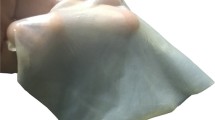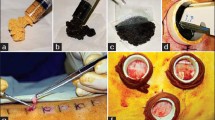ABSTRACT
Purpose
An ethyl alcohol-precipitated silk sericin/PVA scaffold that controlled the release of silk sericin was previously developed and applied for the treatment of full-thickness wounds in rats and demonstrated efficient healing. In this study, we aimed to further evaluate the clinical potential of this scaffold, hereafter called “silk sericin-releasing wound dressing”, for the treatment of split-thickness skin graft donor sites by comparison with the clinically available wound dressing known as “Bactigras®”.
Methods
In vitro characterization and in vivo evaluation for safety of the wound dressings were performed. A clinical trial of the wound dressings was conducted according to standard protocols.
Results
The sericin released from the wound dressing was not toxic to HaCat human keratinocytes. A peel test indicated that the silk sericin-releasing wound dressing was less adhesive than Bactigras®, potentially reducing trauma and the risk of repeated injury upon removal. There was no evidence of skin irritation upon treatment with either wound dressing. When tested in patients with split-thickness skin graft donor sites, the wounds treated with the silk sericin-releasing wound dressing exhibited complete healing at 12 ± 5.0 days, whereas those treated with Bactigras® were completely healed at 14 ± 5.2 days (p = 1.99 × 10−4). In addition, treatment with the silk sericin-releasing wound dressing significantly reduced pain compared with Bactigras® particularly during the first 4 postoperative days (p = 2.70 × 10−5 on day 1).
Conclusion
We introduce this novel silk sericin-releasing wound dressing as an alternative treatment for split-thickness skin graft donor sites.








Similar content being viewed by others
REFERENCES
Werner S, Grose R. Regulation of wound healing by growth factors and cytokines. Physiol Rev. 2003;83:835–70.
Winter GD. Formation of the scab and the rate of epithelization of superficial wounds in the skin of the young domestic pig. Nature. 1962;193:293–4.
Harle S, Korhonen A, Kettunen JA, Seitsalo S. A randomised clinical trial of two different wound dressing materials for hip replacement patients. J Orthopaed Nurs. 2005;9:205–10.
Ramakrishnan KM, Jayaraman V. Management of partial-thickness burn wounds by amniotic membrane: a cost-effective treatment in developing countries. Burns. 1997;23:S33–6.
Gore MA, Akolekar D. Evaluation of banana leaf dressing for partial thickness burn wounds. Burns. 2003;29:487–92.
Middelkoop E, van den Bogaerdt AJ, Lamme EN, Hoekstra MJ, Brandsma K, Ulrich MMW. Porcine wound models for skin substitution and burn treatment. Biomaterials. 2004;25:1559–67.
Visavadia BG, Honeysett J, Danford MH. Manuka honey dressing: an effective treatment for chronic wound infections. Brit J Oral Max Surg. 2008;46:55–6.
van der Weyden EA. Treatment of a venous leg ulcer with a honey alginate dressing. Br J Community Nurs. 2005;10:S21, S24, S26-S27.
Skorkowska-Telichowska K, Czemplik M, Kulma A, Szopa J. The local treatment and available dressings designed for chronic wounds. J Am Acad Dermatol. 2013;68:e117–26.
Aramwit P, Sangcakul A. The effects of sericin cream on wound healing in rats. Biosci Biotechnol Biochem. 2007;71:2473–7.
Aramwit P, Kanokpanont S, De-Eknamkul W, Kamei K, Srichana T. The effect of sericin with variable amino-acid content from different silk strains on the production of collagen and nitric oxide. J Biomater Sci Polym Ed. 2009;20:1295–306.
Aramwit P, Kanokpanont S, Nakpheng T, Srichana T. The effect of sericin from various extraction methods on cell viability and collagen production. Int J Mol Sci. 2010;11:2200–11.
Terada S, Nishimura T, Sasaki M, Yamada H, Miki M. Sericin, a protein derived from silkworms, accelerates the proliferation of several mammalian cell lines including a hybridoma. Cytotechnology. 2002;40:3–12.
Sasaki M, Kato Y, Yamada H, Terada S. Development of a novel serum-free freezing medium for mammalian cells using the silk protein sericin. Biotechnol Appl Biochem. 2005;42:183–8.
Tsubouchi K, Igarashi Y, Takasu Y, Yamada H. Sericin enhances attachment of cultured human skin fibroblasts. Biosci Biotechnol Biochem. 2005;69:403–5.
Dash R, Mandal M, Ghosh SK, Kundu SC. Silk sericin protein of tropical tasar silkworm inhibits UVB—induced apoptosis in human skin keratinocytes. Mol Cell Biochem. 2008;311:111–9.
Aramwit P, Siritienthong T, Ratanavaraporn J. Accelerated healing of full-thickness wounds by genipin-crosslinked silk sericin/PVA scaffolds. Cells Tissues Organs. 2013;197:224–38.
Siritienthong T, Ratanavaraporn J, Aramwit P. Development of ethyl alcohol-precipitated silk sericin/polyvinyl alcohol scaffolds for accelerated healing of full-thickness wounds. Int J Pharm. 2012;439:175–86.
Lee K, Kweon H, Yeo JH, Woo SO, Lee YW, Cho CS, et al. Effect of methyl alcohol on the morphology and conformational characteristics of silk sericin. Int J Biol Macromol. 2003;33:75–80.
Siritientong T, Srichana T, Aramwit P. The effect of sterilization methods on the physical properties of silk sericin scaffolds. AAPS Pharm Sci Tech. 2011;12:771–81.
Wittaya-areekul S, Prahsarn C. Development and in vitro evaluation of chitosanpolysaccharides composite wound dressings. Int J Pharm. 2006;313:123–8.
Standard Methods for the Examination of Water and Wastewater, Copyright by American Public Health Association, American Water Works Association, Water Environment Federation, 1999. Available from URL: http://www.mwa.co.th/download/file_upload/SMWW_1000-3000.pdf.
Takahashi Y, Yamamoto M, Tabata Y. Osteogenic differentiation of mesenchymal stem cells in biodegradable sponges composed of gelatin and β-tricalcium phosphate. Biomaterials. 2005;26:3587–96.
Zhang Y, Hazelton DW, Knoll AR, Duval JM, Brownsey P, Repnoy S, et al. Adhesion strength study of IBAD–MOCVD-based 2G HTS wire using a peel test. Physica C. 2012;473:41–7.
ISO10993-6. Biological evaluation of medical devices—part 6: tests for local effects after implantation.
Politano VT, Api AM. The research institute for fragrance materials’ human repeated insult patch test protocol. Regul Toxicol Pharm. 2008;52:35–8.
Akhtar N, Yazan Y. Formulation and in-vivo evaluation of a cosmetic multiple emulsion containing vitamin C and wheat protein. Pak J Pharm Sci. 2008;21:45–50.
Rakel BA, Bermel MA, Abbott LI, Baumler SK, Burger MR, Dawson CJ, et al. Split-thickness skin graft donor site care: a quantitative synthesis of the research. Appl Nurs Res. 1998;11:174–82.
McNamee P, Api A, Basketter D, Gerberick G, Gilpin D, Hall B, et al. A review of critical factors in the conduct and interpretation of the human repeat insult patch test. Regul Toxicol Pharmacol. 2008;52:24–34.
Angspatt A, Taweerattanasil B, Janvikul W, Chokrungvaranont P, Wimon S. Carboxymethylchitosan, alginate and tulle gauze wound dressings: a comparative study in the treatment of partial-thickness wounds. Asian Biomed. 2011;5:413–6.
Hunt TK, Zederfeldt B, Goldstick TK. Oxygen and healing. Am J Surg. 1969;1:521–5.
Fraise AP. Choosing disinfectants. J Hosp Infect. 1999;43:255–64.
Rajendran R, Balakumar C, Sivakumar R, Amruta T, Devaki N. Extraction and application of natural silk protein sericin from Bombyx mori as antimicrobial finish for cotton fabrics. J Text Inst. 2012;103:458–62.
Hoglen NC, Regan SP, Hensel JL, Younis HS, Sauer JM, Steup DR, et al. Alteration of Kupffer cell function and morphology by low melt point paraffin wax in female Fischer-344 but not Sprague–Dawley rats. Toxicol Sci. 1998;46:176–84.
Flescher E, Gonen P, Keisari Y. Oxidative burst-dependent tumoricidal and tumorostatic activities of paraffin oil-elicited mouse macrophages. J Natl Cancer Inst. 1984;72:1341–7.
Epstein JH. Postinflammatory hyperpigmentation. Clin Dermatol. 1989;7:55–65.
ACKNOWLEDGMENTS AND DISCLOSURES
We gratefully acknowledge the financial support from the Thailand Research Fund through the Royal Golden Jubilee Ph.D. Program (Grant No. PHD/0115/2551) to Tippawan Siritientong and Pornanong Aramwit and also the support from the National Research Council of Thailand.
Author information
Authors and Affiliations
Corresponding author
Electronic Supplementary Material
Below is the link to the electronic supplementary material.
Figure S1
(A) Percentage of migrated L929 mouse fibroblast cells after the monolayer was scratched and cultured in the presence of the wound dressings for  and 72 h (■). * p < 0.05 when compared to the control (cells cultured on a polystyrene plate without sample) was considered significant. (B) Phase-contrast microscopic images of L929 cells after the monolayer were scratched (t0) and cultured in the presence of the wound dressings for 24, 48, and 72 h, respectively. (JPEG 83.6 kb)
and 72 h (■). * p < 0.05 when compared to the control (cells cultured on a polystyrene plate without sample) was considered significant. (B) Phase-contrast microscopic images of L929 cells after the monolayer were scratched (t0) and cultured in the presence of the wound dressings for 24, 48, and 72 h, respectively. (JPEG 83.6 kb)
Rights and permissions
About this article
Cite this article
Siritientong, T., Angspatt, A., Ratanavaraporn, J. et al. Clinical Potential of a Silk Sericin-Releasing Bioactive Wound Dressing for the Treatment of Split-Thickness Skin Graft Donor Sites. Pharm Res 31, 104–116 (2014). https://doi.org/10.1007/s11095-013-1136-y
Received:
Accepted:
Published:
Issue Date:
DOI: https://doi.org/10.1007/s11095-013-1136-y




